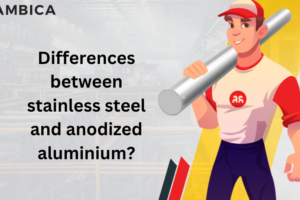Austenitic stainless steel is admired for grades used in common high-fidelity applications. These are iron-based amalgamations with 16-25% of chromium with other alloying agents. Chromium and molybdenum protect austenitic grade from general and pitting corrosion. Nickel strengthens and stabilizes its austenite structure with manganese and nitrogen.
Austenitic grades are non-magnetic in nature and pose excellent weldability ad formability. These grades can be successfully used in cryogenic applications and even in the red hot temperature of furnace and heat-exchangers. The strength, durability, visual appeal, easy maintenance, and contribution towards a sustainable environment are some added perks to its applications.
Grade 204 and 304 are popular austenitic grades with face-centered microstructure and maintain their niche of applications and differences. The major difference is the distribution of elements in chemistry.
Difference between grades 204 and 304
The chemical compositions define attribution, mechanical and physical parameters. Here, the key component is nickel. Grade 304 contains 18-20 % of chromium and 8-10% of nickel. On the other hand, grade 204 contains 18% chromium and 0.5% of nickel. The significant difference is nickel content is vast relatively. One more differentiation is created by manganese. Grade 304 has a manganese content of 2%, and grade 204 has 5% of manganese by weight. As a result, the corrosion resistance, strength, price, use differs for both grades.
| Grade | Carbon
(max)% |
Manganese
(max)% |
Silicon
(max)% |
Phosphorus
(max)% |
Sulfur
(max)% |
Chromium
(max)% |
Nickel
(max)% |
Nitrogen
(max)% |
Molybdenum
(max)% |
Copper
(max)% |
| 304 | 0.08 | 2.0 | 0.75 | 0.045 | 0.030 | 18-20 | 8-10 | 0.10 | – | – |
| 202 | 0.10 | 6-8 | 2.0 | 0.040 | 0.015 | 16-18% | 2.0 | – | 1.0 | 2-3.5 |
How to identify grades 204 and 304?
Grade 204 and 304 are both austenitic stainless steel and non-magnetic in nature. Grade 304 has considerably superior corrosion resistance when exposed to saltwater, compared to grade 204. In the spark test, grade 204 produces yellow-red sparks, whereas grade 304 will produce more reddish sparks with fast speed. Other differences can be obtained with magnetic spots and laboratory tests.
Corrosion resistance (Grade 204 versus 304)
Grade 204 produces weakened corrosion resistance when compared to grade 304. But it does not mean it is not corrosion-resistant at all. Grade 204 performs well in general or less corrosive mediums. Its chemistry does not hold good for chloride environments. Grade 204 is an economical option with compromised corrosion resistance.
Grade 304 has more nickel in its compound and produces excellent corrosion resistance and strength. Its applications cover kitchen utensils to power generation equipment.
Cost difference
Nickel is an essential commodity with volatile prices. It is expensive in nature. 304 Stainless steel contains a significant amount of nickel when compared to grade 204. So, grade 304 automatically becomes an expensive material. But this cost comes with numerous advantages and practical applications.
Inferentially, grade 204 is an economical option and is used in indoor applications. Grade 304 is a popular and cost-effective stainless steel with excellent corrosion resistance and strength with an expansive range of applications.




